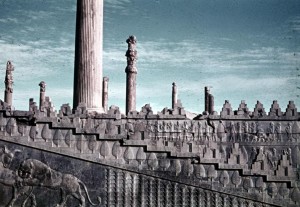At the moment, much of my reading and writing is focused on a project on the problem of how to deal with the question of ethnicity and identity in the material record. While this might, on the surface of things, seem quite separate from my larger project this year of examining Upper Egypt as a border zone where material culture played an important role in the negotiation of identities—Egyptian, Nubian, Greek—the topics are actually intertwined in important ways. Upper Egypt is a peripheral zone, in a certain sense, at the edge of the Egyptian polity in the Ptolemaic period. The deployment of certain ceramic forms, the consumption of canonical Egyptian religious imagery and the performance of loyalty to the dynasty ensconced in Alexandria are all aspects of life in this border community. My parallel interest in Achamenid art and material culture shares some of the same questions: how is it possible to see negotiations of status, class, gender and other aspects of identity operating in the material culture of the areas controlled by the Achaemenid empire?

In this instance, I’m working on an essay devoted to teasing out how ethnicity (a modern construct, surely) was operative in the material sphere of the Achaemenid empire between the 6th and 4thcenturies BCE. The Achaemenid Empire at its height was enormous, stretching from western Asia Minor to Central Asia. Its heartland was Fars in modern Iran and the empire was the direct inheritor of the great first millennium dynasties of Mesopotamia, especially the Neo-Assyrian Empire and their immediate predecessors, the Medes. These imperial powers, like the later Achaemenids, were faced with the challenge of making an empire out of a range of diverse regions with their own linguistic and cultural traditions.
The Achaemenid imperial centers of Susa, Persepolis, and Pasargadae were used as staging grounds for the creation of a visual and rhetorical articulation of ‘empire’ as a project that subjugated and incorporated a huge range of peoples and places. This is most clearly evident on the great procession friezes of the Apadana at Persepolis on which various cultural groups are shown bringing tribute to the Great King during a festival celebrating the new year.

This kind of image presents certain attributes of dress and commodity as symbolic of a particular place through a representation of its valuable resources and peoples. It is a kind of essentializing representation that borders on a notion of cultural stereotyping, but the picture is infinitely more complex than this.
My own work on questions of ethnicity and style has led me to a much more contextualized approach to questions of identity and the way that material objects can be understood to represent or construct identity. In an article now a few years old I examined a category of seal known as a “Graeco-Persian” that blends Achamenid and Greek aspects both in terms of style and subject. In this article, I argued that how a seal was actually used was a more important indicator of the meaning of certain aspects of style and iconography than were any preconceived notions about the nature of Greek or Persian tastes or capabilities. My current project on this topic works to understand a broader and more centrally-driven assessment of questions of ethnicity under the Achaemenids and how material like those shown above work alongside more personal markers of identity, such as seals. I’ll be presenting a short synopsis of this project at a conference in January at the University of Pennsylvania (http://www.classics.upenn.edu/conference/2012) with the paper published in a volume coming out of that gathering.
Stay tuned for more!
